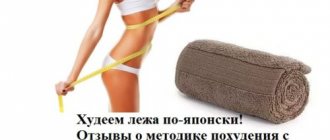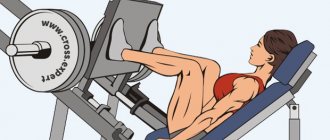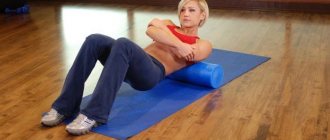Is exercise therapy necessary for a hernia?
Exercise therapy for a hernia is mandatory. The goal of such therapeutic exercises is to improve the patient’s physical condition, remove pain, and prevent its occurrence. Well-designed lessons:
- stimulate vital functions;
- increase the endurance of muscle structures and the reactivity of the body (the ability to respond to various factors);
- involve mechanisms that are involved in the pathological process in the general reaction, which contributes to their elimination.
Therapeutic exercise does not harm the body, since the exercises are designed to reduce the load on the spine. They not only relieve pain, but also “teach” the body to avoid injury in the future.
Regular exercise therapy helps:
- Relieve pain and speed up the healing process.
- Form correct posture.
- Improve strength, endurance, coordination.
- Evenly distribute the load across the parts of the spinal column.
- Restore mobility.
- Prepare the body for strength and aerobic exercise.
Therapeutic exercises strengthen the muscles that support the spine and prevent the appearance of new hernias. Exercises involve not only the back, but also the abdominal muscles. The body begins to move better, stiffness disappears, and the risk of injury decreases.
Pros and cons of the technique
Japanese gymnastics for weight loss with a roller has its positive and negative sides. The advantages include:
- Easy to use - the exercises do not take much time, even a child can do them.
- Accessibility – gymnastics does not require exercise equipment, massage or a gym. All you need is a roll of terry towel tied with strong thread.
- Complex action - the exercise affects all parts of the spine, removes cellulite, lifts the chest, reduces the waist and hips.
- Safety – there is no risk of injury if you exercise caution and technique.
Japanese gymnastics also has relative disadvantages. These include the following factors:
- Discomfort at the beginning of training or with incorrect body posture.
- Low efficiency of weight loss - you can lose weight only by reducing volume, but your weight practically does not change.
- The need for a diet - to obtain lasting weight loss results, you must not exceed 1400 kcal per day.
In what cases is it prohibited to do exercise therapy for a hernia?
Any physical exercise is prohibited during the acute phase of pain. If deterioration occurs, go to the clinic and undergo a course of drug therapy. And only when the pain goes away, with the doctor’s permission, you can start training.
Each type of intervertebral hernia has serious complications, so you should not delay treatment.
See how easy it is to get rid of a hernia in 10 sessions
Other contraindications:
- Hypertension.
- Serious heart diseases - ischemia, chronic failure, etc.
- Recent surgery, after which you should not strain (temporary contraindication).
- Heat.
- Colds, flu and other infectious diseases.
- Bleeding – incl. nasal
Contraindications
If the roller exercise works exactly as Dr. Fukutsuji claims (it moves bones and internal organs), it is clear that this is a serious process that will ultimately affect not only your figure, but also your health. And if initially there are problems with the spine, bones, joints and organs in the abdominal cavity, you should be careful with such gymnastics. Therefore, the Japanese method of losing weight has special contraindications that cannot be ignored. These include diseases:
- spine: sciatica, intervertebral hernia, myositis, osteoporosis, osteochondrosis, protrusion, radiculitis, spondylosis, tumors, ankylosing spondylitis;
- joints: bursitis, tendinitis, coxarthrosis, periarthritis;
- bones: osteopathy and chondropathy;
- gastrointestinal tract;
- liver;
- kidney
Negative reviews claiming that the Japanese method of losing weight is not only ineffective, but also causes back pain, are dictated in most cases by non-compliance with contraindications. If a person with protrusion of intervertebral discs begins to perform the exercise, this may result in the formation of an extensive hernia and disability. Therefore, if you have such diseases, you should consult your doctor.
Exercise technique
The best time for exercise therapy is morning or evening. Exercises should be done smoothly, slowly, after warming up.
When performing exercise therapy, pay attention to your body’s reaction. If severe discomfort, pain in the heart, or back occurs, the training should be stopped or the load reduced.
You need to exercise daily, unless your doctor says otherwise. For therapeutic exercises to bring results, the load must be increased slowly: start with 3-4 repetitions, after a week do ten (no more).
At first, exercise therapy should be performed under the supervision of a doctor. He will show you how to practice correctly and correct any inaccuracies. He will tell you when to increase the number of repetitions and the load.
Weight loss program
Initially, prepare yourself for the fact that the Japanese Fukutsuji method is a long-term weight loss. But it is precisely this fact that guarantees a lasting result that will last a long time.
It is recommended to exercise in the morning (according to ancient Eastern teachings, this is the best time for physical and meditative practices), at the same hours, which allows the body to get used to the load and minimize stress.
This is not interval training, so you need to do it every day, without missing a single day. If there is no load, the bones will begin to separate again.
Sample training program
With such a program using the Japanese method for 3 months, you can reduce your waist size by 5 cm, completely remove a sagging belly and straighten your posture. If you are satisfied with the results, you can stop training and keep your body in shape using other methods - through proper nutrition and regular exercise. But most people continue to practice the Fukutsuji exercise to prevent diseases of the spine and joints and to avoid subsequent bone separation that occurs with age.
Set of exercises
Each case has its own characteristics, so a training complex should be developed by a doctor. This is an important point: wrong actions can enlarge the hernia and increase pain.
A set of exercises for hernia of the lumbar and lumbosacral region
The lumbar region not only bears the weight of the body, but is also responsible for cushioning (softening) the shocks to which the back is exposed. Therefore, any displacement of the disc at the bottom of the spine leads to serious consequences, and hernias of the lumbosacral region cause severe pain. A person cannot turn the body to the right or left, bend over, and sometimes sit, stand, or lie down. Regular exercise therapy will prevent this.
Read about lumbar hernia here.
Correct position for exercise therapy for lumbar hernia
Exercises for lumbar hernia should be performed lying down. In this position, the load on the lower vertebrae does not exceed 25 kg. At the same time, when a person stands, this number increases by 4 times, while sitting – by 6 times. When the body moves, the numbers increase even more.
Exercise therapy for a herniated lumbar spine should be done:
- on the stomach;
- on the back;
- on the side;
- On knees.
The best exercises for the lumbar region with a hernia
The simplest and most effective exercise looks like this:
- Lay out a mat and sit near a wall.
- Lie on your back so that your legs are stretched up the wall. Hands should be along the body.
- Lie like this for a few minutes. If possible, there is no pain, half an hour is possible.
- For comfort, place a bolster or pillow under your lower back.
The simplest and most effective exercise for spinal hernia
The best exercise therapy exercises for the prevention and treatment of hernia in the lumbar region are also considered half-cobra, cobra, cat, and bird-dog.
half-cobra
One of the most effective exercise therapy exercises for hernia of the lumbosacral spine is the half-cobra. It helps return the protrusion inside the disc and speed up healing. Do the exercise slowly and carefully. If pain occurs, it is better to refuse to perform it:
- Lie on your stomach with your elbows bent so that your palms are on both sides of your face.
- Slowly arch your back upward. Elbows on the floor, level with the shoulders.
- Stay in this position for 10 seconds.
- Slowly return to the starting position.
- Repeat 10 times.
- Gradually increase the time to 30 seconds.
Half cobra exercise
Cobra
This exercise therapy exercise for lumbosacral hernias is a heavier version of the half-cobra. It also helps to return the herniation inside the disc and speed up healing. Plus - it stretches ligaments better and makes the spine more flexible.
Do this exercise no earlier than you have mastered the half-cobra pose. Instructions:
- Lie on your stomach, arms bent at the elbows, palms near your face.
- From a lying position, begin to slowly straighten your back, without lifting your palms from the floor, until your arms are completely straight.
- Hold the position for 10 seconds. (gradually increase to 20-30 seconds)
- Return to the starting position.
- The maximum number of actions is 10 times. If you feel pain and you are not ready for the exercise yet, don’t do it.
Exercise cobra
Cat
Cat is one of the most popular exercises for lumbar hernias. It reduces pressure on the painful area, improves the mobility of the spinal column, relieves pain, and relieves tension.
Do the exercise like this:
- Bend your legs, stand on all fours, arms straight, resting on the floor at shoulder level.
- Take a deep breath and bend your spine upward, lower your head, look into your navel.
- Exhale and bend your lower back towards the floor so that your head looks up at the ceiling. The stomach should lower to the floor as much as possible, but do not bend your arms.
- Repeat 5-10 times.
Exercise cat
Bird dog
The Bird Dog exercise strengthens and stabilizes the lower back and deep muscles of the spine. It helps improve posture and avoid the appearance of a hernia.
The action plan is as follows:
- Get on your knees. Your arms should be straight.
- Raise your left arm and extend it forward until it is parallel to your torso. At the same time, lift your right leg, take it back, it should be at the same level as your left hand.
- Maintain this position for 2-3 seconds.
- Return to the starting position.
- Repeat with your right arm and left leg.
- Do this 10 times.
Bird-dog exercise
Prohibited exercises
If you have a lumbar hernia, you cannot:
- do a leg press, when a weight is attached to a platform, and a person in a lying position must push it up;
- bending over with straight legs - this increases the load on the intervertebral disc and lower back pain;
- do exercises to twist the spine, including lateral, oblique, double - they increase the protrusion of the intervertebral hernia and cause complications.
- jump, do aerobics, run.
What types of intervertebral hernias are most difficult to treat?
4 stages of treatment for intervertebral hernia
A set of exercises for thoracic hernia
Thoracic hernias are more difficult to treat than others. The main reason is that the spine in this area is excessively bent and it is not easy to straighten it in order to reduce the pressure of the hernia on the nerve endings. The task of exercise therapy for thoracic hernia is to solve this problem.
Read about the symptoms, types and treatment of thoracic hernias here.
Correct positions for exercise therapy for thoracic hernia
Therapeutic exercises for a thoracic hernia can be done lying down, sitting on a chair, or standing. Perform exercises slowly, with calm breathing.
Best exercises
- Stand straight, arms along your body. Rotate your shoulders first forward, then back (3-5 times). Hands walk along the body.
- Asynchronous shoulder rotation - right up, left down. The head looks forward.
- Sit on the floor, grab your heels with your hands, legs bent at the knees. Start doing soft rolls on your back (3-5 times). As you inhale, roll so that your cervical region (preferably the back of your head) touches the floor; as you exhale, your heels should touch it.
- Lie on your back on a cushion, place it under your thoracic spine. Slowly roll on the roller so that it first rises to the cervical region and then descends to the lumbar region.
- Starting position, as in exercise No. 4. Raise your hands to your face, elbows on the floor. Place your chin on your palms, extend your fingers, and stay there as much as possible.
Roll on your back and exercise on a roller for a thoracic hernia
Prohibited exercises
If you have a thoracic hernia, you cannot do exercises with weights or do pull-ups on the horizontal bar. Active movements are prohibited - jumping, fitness, aerobics. Fast running is prohibited; preference is given to jogging.
A set of exercises for cervical hernia
Pain from an upper hernia affects the upper back. It has a sharp, piercing character. It is difficult for a person to raise his arm, turn or tilt his neck. The task of exercises for hernias of the cervical spine is to stretch the distance between the vertebrae so that the protrusion puts less pressure on the nerves.
Read all about the symptoms and treatment of cervical hernia in this article.
Correct positions for exercise therapy for cervical hernia
If you have a cervical hernia, you can do the following:
- standing;
- lying down;
- sitting on a chair;
- On knees.
Best exercises
The activities described below can be done standing or sitting in a chair:
- Relax your shoulders, keep your back straight. Slowly lower your head onto your left shoulder. Do not rush, especially if the pain is felt on this side. Fix the position, count to 7, straighten your neck. Repeat the exercise on the other side.
- Return to the starting position. Move your head slowly up and down.
- Next, start turning your head - to the right and left. Having fixed the turn, count to 7, return to the starting position.
Head tilt with cervical hernia
The “half-cobra” exercise (see above) gives good results. It allows you to effectively stretch the spine, incl. cervical region
Prohibited exercises
For a cervical hernia, the following are prohibited:
- pull-up at a tournament;
- exercises with weights and twisting;
- push-ups
about the author
The Japanese doctor Fukutsuji is our contemporary, but practically nothing is known about him. Dealing with the treatment of the spine and joints, for 10 years he developed a system of exercise therapy to relieve back pain, practicing all the exercises from his own experience. As a result, the complex never saw the light of day for the only reason - from the variety of everything that he tried, he chose only one position, and the static one - with a towel roll. It was this that showed the best results and relieved not so much problems with the lower back as from extra pounds and centimeters on the waist.
In the early 2000s. from the pen of a talented doctor the book “Lose weight lying down” was published. More than 6 million copies were published and sold in Asian countries. Many who tried the method of the Japanese doctor Fukutsuji thanked him for a new life without back pain and excess weight. The book was translated into other languages and became widespread in Russia and the West.
However, there were also those who criticized Dr. Fukutsuji’s method with a roller, declaring not only its ineffectiveness (not everyone was able to lose weight by practicing it), but also that it was harmful to the spine (orthopedists, rheumatologists and neurologists often speak out about this). Despite this, the Japanese doctor is popular in his country, conducts online trainings and seminars, and teaches patients the correct technique for performing his original exercise. According to the media, people from all over the world are flocking to him for help.
Other therapeutic exercises
In addition to physical therapy, the following are used to treat spinal hernia:
- Bubnovsky method;
- exercises according to Dikul;
- water gymnastics;
- yoga and pilates.
Each of these methods has its own characteristics. Before you start performing them, find out their differences from conventional physical therapy, the benefits and harms of a hernia, when you can do it or not.
According to the Bubnovsky method
Dr. Sergei Bubnovsky wrote about back hernia in the book “Spinal hernia is not a death sentence.” He developed most of the exercises taking into account the simulators that are available in his clinic.
Opinions about the method are mixed. There are many cases that after treatment in his clinics hernia:
- not only did it not decrease, but increased, it was even necessary to resort to surgery;
- the pain disappeared in one place, appeared in another, requiring hospital treatment and even surgical intervention.
The main reasons for failure are rigid, heavy exercises, which are strictly prohibited in case of a spinal hernia (strength loads, twisting).
If you still decide to try gymnastics using this method, avoid training that is prohibited if you have a back hernia. It is better to do the complex for prevention, when the acute phase has passed, there is no pain.
According to Dikul
Exercises suggested by Valentin Dikul, director of a rehabilitation center for patients with back injuries, have a good effect on the spine. You can learn about his method in his book “Treating the back from hernias and protrusions.” He offers different types of training, including standard therapeutic exercises that can be performed for spinal hernia (half-cobra, cat).
The complex that Dikul offers consists of several stages:
- Exercises aimed at eliminating pain. They are performed with a small amplitude, without additional load. Basic movements are a standard exercise therapy complex. Course – 3 times a week for 2-4 months.
- Exercises aimed at strengthening muscles are a rehabilitation period when the pain has gone away. At this stage, you can include strength training. Course – 4 times a week for 2-3 years.
- Complete workouts designed taking into account the presence of a hernia, without negative effects on the affected area.
Exercises must be performed in strict sequence, do not change places, and do not increase the number of repetitions. The load (light dumbbells) can be taken no earlier than the complex is mastered and the pain disappears. Between exercises you need to rest for 2-3 minutes.
Exercises in water
Swimming gives good results in the treatment of spinal hernias. Water relieves stress from the back and calms the nervous system. It helps to better stretch the space between the discs and reduce the pressure of the hernia on the nerve fibers. The main thing is to choose the right instructor and exercises.
The following activities have a good effect:
- The face is lowered into the water, the arms are extended, holding a swimming board (you can use a crossbar installed around the perimeter of the pool), the back is straight. The legs swim in the crawl style.
- Lie on your side, your right hand rests on the board, your left along your torso. The legs work in the crawl style.
- Swim on your back. Hands hold the board on your stomach, legs swim in crawl style.
If the pool is shallow (water up to your chest), you can take steps in place with your knees raised high. At this time, the arms move as if running. Gentle turns of the body to the right and left have a good effect.
The only contraindication for water exercises is the acute phase of pain. Jumping into the water is strictly prohibited. You can't swim with your head held high. The breaststroke and butterfly styles are undesirable.
Yoga and Pilates for hernia
Yoga and Pilates are based on slow loads without overexertion. They improve the condition of muscles, tendons, and stretching. But with a herniated disc, many exercises are prohibited (bridges, twisting, strong stretches). Moreover, they cannot be done during an exacerbation period.
When giving preference to these methods, pay attention to exercises that are designed specifically for spinal hernia. The basic complex is not much different from exercise therapy - cobra, cat, bird-dog.
During the period of pain, avoid any strength or other prohibited exercises. If pain occurs, stop exercising. Additional equipment that is often used in Pilates (dumbbells, other weights) can be taken only at the stage of remission, when the pain has gone.
Exercise therapy after hernia removal
To recover normally after removal of a spinal hernia, you cannot do without physical therapy. Rehabilitation takes place in several stages:
- The first two weeks after surgery. The patient stays in the hospital, must wear a corset, and undergo medication treatment. You can get up for 2-3 days, sitting is not recommended. It is forbidden to lift weights exceeding 3-5 kg, and you cannot do massage.
- 2-6 weeks. The patient is discharged from the hospital. He must go to the clinic for physiotherapeutic procedures. You can't sit or stand for a long time yet. Weight no more than 8 kg.
- 1.5-2 months after operation. The attending physician prescribes exercise therapy and massage.
- 2-6 months The doctor allows you to increase the load when performing exercise therapy. Lifting weights and overworking is still not an option.
- After 6 months You need to take a course of exercise therapy on special simulators.
Thus, after the operation, the patient is almost motionless for the first two weeks. During this time, the muscles weaken and slightly atrophy. Your doctor will tell you when to start therapeutic exercises. Typically, exercise therapy is prescribed from 6 weeks after surgery. Activities at this time are the same as during the treatment of a hernia, depending on the location of the protrusion. But you can increase the load only by the doctor’s decision.
Read about all methods of treating hernias in our article “Treatment of intervertebral hernia.”
When you can’t do exercises after removal
After removal of a hernia, exercise therapy must be prescribed by a doctor, and the patient must strictly follow his instructions.
For the first time after surgery, you need to wear a corset, which helps the sutures heal. At this time, any loads are prohibited. Weights up to 5 kg can only be lifted with a corset. Active exercises are prohibited, incl. sharp twisting movements.
2 weeks after the operation, the patient is discharged from the hospital, but at this time exercise therapy is still prohibited. Only after at least 1.5 months. (at this point the stitches are tightened) and after examination by a doctor, you can start doing exercises.
Best exercises
The doctor prescribes exercise therapy based on the clinical picture. Classes are only possible under the supervision of a specialist. The main efforts are aimed at strengthening muscle mass and restoring the functioning of the operated part of the spine. If the patient’s condition allows, he is recommended to perform “Half-Cobra”, “Cobra”, “Cat”, turns and tilts of the head, then move on to more complex gymnastics.
6 months after the operation, the rehabilitation specialist prescribes work on simulators. If necessary, the patient undergoes tests, based on which the computer develops an exercise program. The patient is engaged in computerized installations that:
- test the patient’s condition during classes, which allows timely adjustment of the program;
- measure and calculate the patient’s muscle strength and range of motion;
- control the activity, excluding the possibility of injury to the spinal column.
The first exercise therapy sessions after surgery should only be carried out under the supervision of a doctor.
When the main rehabilitation is over, the patient needs to go to group classes in therapeutic exercises. If this is not possible, he can do the exercises at home, taking into account the recommendations of a rehabilitation specialist and exercise therapy instructor.
We use non-surgical hernia treatment techniques
Read more about our unique technique
FAQ
Will exercise therapy help you recover faster after a hernia removal?
Yes, it will help. The main thing is to strictly follow all the doctor’s advice, do not rush, and do not increase the load ahead of time.
Is it possible to do exercise therapy for Schmorl's hernia?
Yes. Exercise therapy can be done for any type of hernia, when the acute pain subsides. The main thing is to choose the right set of exercises. If you have a Schmorl's hernia, you definitely need to pump up and strengthen the muscles, especially the back and abdomen. It is important to remember: weight bearing is contraindicated.
Is it possible to do exercise therapy for a sequestered hernia?
It is possible, but we must proceed from the fact that exercise therapy cannot be done during the acute phase. When the pain subsides, light exercise is allowed after consulting a doctor. Water gymnastics gives a good effect.
Themes
Intervertebral hernia, Spine, Pain, Treatment without surgery Date of publication: 11/12/2020 Date of update: 03/16/2021
Reader rating
Rating: 5 / 5 (2)










